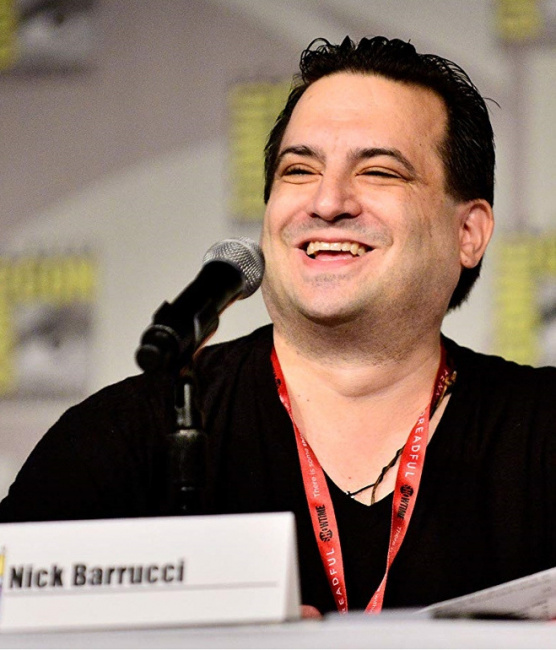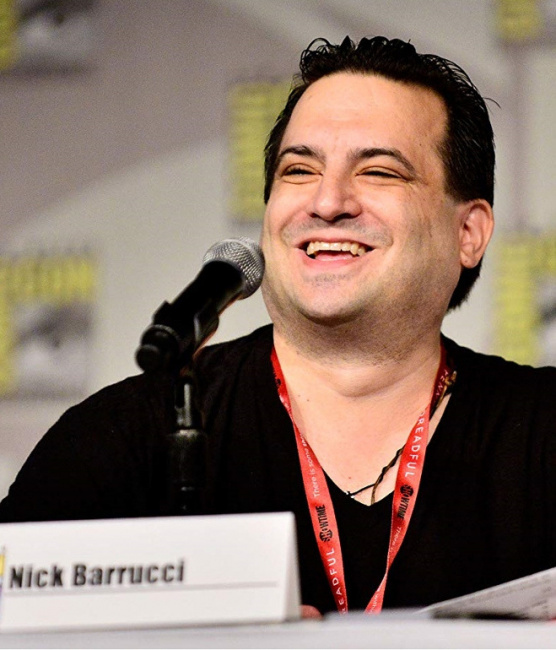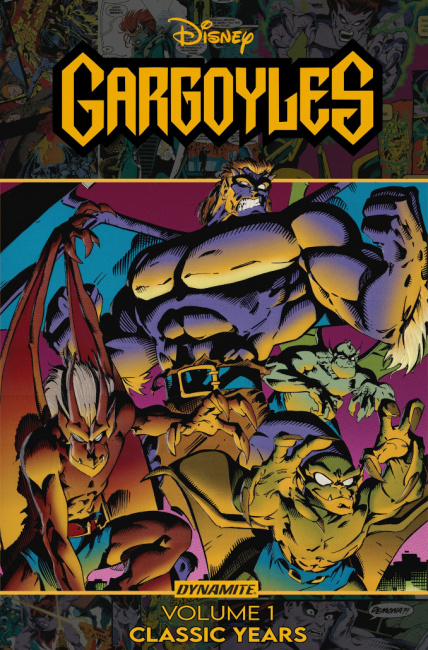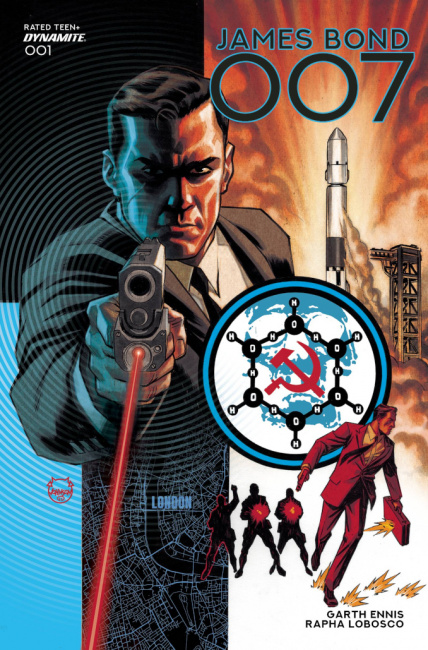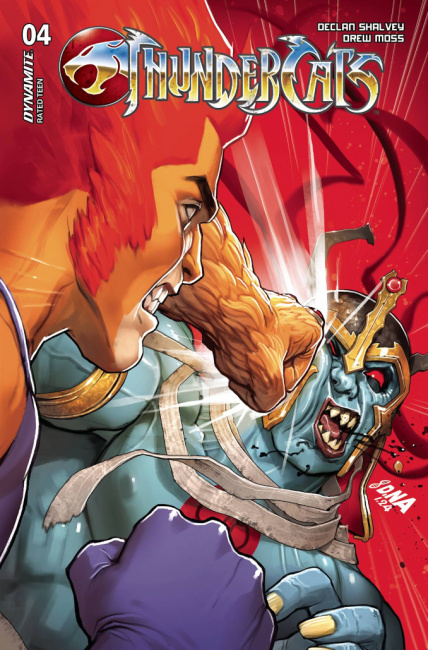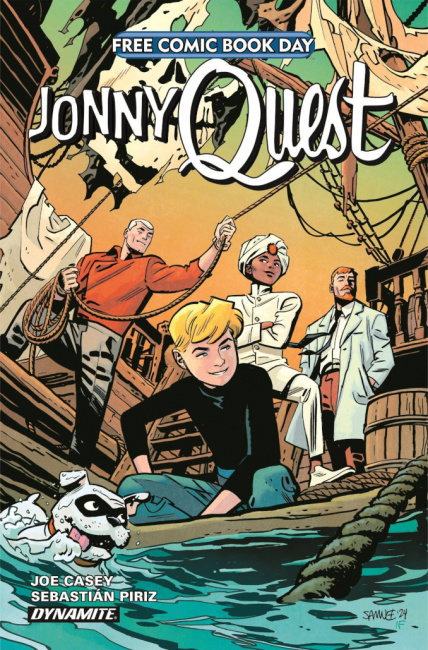Changing Channels, Including Kickstarter, Output, Variants, Diamond, and Disney and Warner Bros. Plans
We recently conducted an email interview with Dynamite Entertainment CEO Nick Barrucci to get his views on the market and Dynamite’s place in it. In Part 1, we discuss recent market trends in comic stores and the book market, and the nature of those changes. In Part 2, we focused on Dynamite’s changing channel mix, its output, use of variants, why it stuck with Diamond, and the company’s plans for its growing Disney and Warner Bros. lines. The interview is lightly edited for length and clarity.
How has the mix of your channels (direct market, book market, and direct-to-consumer, including Kickstarter) changed in recent years, and why?
To a degree the direct-to-consumer business is growing the quickest. Kickstarter, done correctly, is the biggest platform for many of us. And on many levels, it’s the highest profile. We have the third highest grossing Kickstarter for graphic novels of all time. The only two titles ahead of us are the Good Omens adaptation by Neil Gaiman, Terry Pratchett and Colleen Doran at #1, and BRZRKR, by Keanu Reeves, Matt Kindt and Ron Garney, at #2. While we’re #3 for graphic novels overall, we’re also the highest grossing reprint graphic novel of all time (the grand way of saying “to date”).
Look, hands down, BOOM! Studios changed the way all publishers looked at Kickstarters. When they launched BRZRKR, and Keanu was front and center, they smashed all records. He brought a passion and love to the campaign that no one could have foreseen. He cares about the medium. There have been many personalities that have come to comics and looked at it as a way of creating content for other media. Keanu showed that he cared about comics and the industry. He was front and center. The fans knew it, they gravitated towards the campaign, and then when it succeeded as well as it did, BOOM! was very smart in how they set up the series. It was one of the best-selling series of this decade, and, I believe, the best-selling periodical of this decade to date. This opened our eyes and we have learned how to make Kickstarter a very important part of our growth. And the best part is, it helps us grow the comics market.
Dynamite’s bringing back the full library of previous Gargoyles comics in collections with a Kickstarter that raised $925,001! Now, in a vacuum, that is fantastic, but what is even more fantastic: without Kickstarter, we probably would have released one collection a year over three years. But because we were able to create awareness with the Kickstarter campaign, (a) we can release all three much more quickly, over the course of a few months following fulfillment of pledges; and (b) the fans who were aware of the Kickstarter but did not back it will pre-order from their local retailer or bookstore. Then the retailers have a great opportunity to capitalize and to sell them to fans. Kickstarter is a plus for the publishers, the retailers, and the fans. It’s helping to grow the market by allowing more content to be created to be sold there and through all channels including comic retailers. Focusing on the positives and growth is key for everyone.
The direct market has changed now with multiple distributors, and some retailers are finding it more challenging, while others just see it as their orders being split differently. A positive is that multiple distributors has created competition, which has been good for retailers in the long run. It has changed things, and hopefully will be smoother for retailers as I think that all of the distributors are working harder to make it easier for our retail partners. At Dynamite we are doing better than previous years, and this should be our strongest year to date. Year over year our numbers are up. We are growing.
The book market has a lot of strengths as well, and our mix of titles allows us to capture a larger audience. I’ve touched on a few of our titles, but we’ve also expanded our children’s line of titles outside of the comics and properties that most normally would expect of us, working with the Postal Service with Mr. Zip, Paw Patrol with Nickelodeon, and multiple other children’s titles, plus our art books and instructional books and books with authors such as Brandon Sanderson’s White Sand. Many of these have a long tail in the book and library market. Amazon still has the greatest reach, but Barnes & Noble and Books-A-Million are growing for us. And the book market is growing beyond them, especially now that we are releasing titles in Walmart, Target and other retailers. The nice thing about the book market sales is that for the most part, with few exceptions, direct market retailers still sell collections two weeks before book market (Lilo & Stitch Ohana collection being the rare exception as June 26th is necessary to sell all copies through all markets; it’s an event).
And the library market, digital market, and foreign sub-licensing have been stable or growing.
When we talked about five years ago (see “ICv2 Interview: Nick Barrucci, Part 1“), you said that Dynamite was producing about 11 to 12 titles a month, down from a high of 27 to 32 titles a month. Where are you at now for title count?
While I think that is still about the average, we are actually publishing less periodical titles some months. Our July-in-store solicitations only has 9 periodicals being offered. This has changed month to month. For example, June had 11 titles offered. I would say we’re still averaging 11 to 12 titles a month, but as July shows, sometimes less, and there probably will be months where we have more.
We’re not as worried about averaging out our line items offered per month. We’re more concerned with maximizing sales and helping retailers with sell-through. For example, Jonny Quest #1 was initially to be offered in June, but then it moved to July, and now it is firmly in August. Many reasons, but it was pushed back to ensure it has the best chance for success and not just placed in June to fill a quota.
Also, our library of backlist collections is strong, and monthly reorders are consistent to strong on most titles. That also adds to the budget which allows us to make publishing decisions that are best for the long term.
We talked about Dynamite’s use of variant covers in that 2019 interview. Has anything changed in your variant strategy since then?
The short answer is, slightly on some books, but with very few exceptions, it has not. ThunderCats #1 had a lot of variant and incentive covers which included six open order covers plus quite a few incentives. Space Ghost #1 only had four open order covers plus incentives. We’ve brought most of our line to no more than four open order covers plus incentives, but we do not succeed as well when we have fewer covers.
There is no one answer that fits all. For example, the new James Bond series by Garth Ennis has one cover, no incentives, and it continues to sell out. Retailers underordered. Should we have created variants or incentives? Possibly, but we didn’t feel that the readers of Bond and Garth cared about variants. We may have been wrong or we may have sold the same amount and still had sell-outs. Perhaps it’s because Dynamite is so intertwined with variant covers and retailer incentives, we have the biggest support when we ensure that we are able to issue books with multiple varying covers and incentives.
Dynamite and BOOM! are the last two publishers from the seven largest comic publishers that are still using Diamond Comic Distributors as your primary distributor. Why did you stick with Diamond when so many of your competitors have moved to other distributors?
We have faith in Diamond, and also we need Diamond as an industry. Without Diamond there would not be many small publishers. Where would we get the next Bone? The next Strangers In Paradise? PRH is too big. Lunar is still growing. If Diamond were to disappear, the diverse voices that the world has would go away for comic retailers. (And a digression, I know we can say that Kickstarter will be a place for new creators and characters, which is happening now, but that is somewhat limited by how many creators can do Kickstarters well. And you do not have creators releasing monthly periodicals on Kickstarter which can be sold in to comic stores.)
Let’s not forget how Diamond has helped or supported struggling retailers over the years when they are having financial challenges.
Marvel led the way of PRH sub-distributing through Diamond, and that carried over to Dark Horse and IDW. And Image, moving to Lunar, still kept Diamond as a sub-distributor. Diamond has a lot of strengths, and those are overlooked by some, and some take them for granted. We do not and we enjoy our relationship with Diamond. The competition allowed Diamond to look at how they operated in some areas and improve upon them. I will add that having faith in Diamond proved to be the right thing. They have addressed the freight issues, they are improving a lot of their services, and we are selling more comics than we ever have. Again, our sales are up across the board.
Dynamite has one of the biggest hits in the periodical comics business this year with ThunderCats – what made that title take off the way it did?
Quite a few things, in my mind, from content, nostalgia creative and marketing of the series. Nostalgia was the first part of the series doing well, but without the other factors, nostalgia alone would not have carried the launch, much less beyond the launch.
With the launch we ensured that we had the front cover to Previews magazine, which was a great selling tool to retailers and fans alike. Also, Declan Shalvey is a GREAT writer, who understands the characters and gave the series, and each character in the series, the ability to shine. Drew Moss’ art has so much energy that it complements Declan incredibly well. Declan and Drew also promoted the heck out of the series.
We also released it in February, which is a slow month for comics. Normally a high-profile launch such as this would be released between May and July, but retailers have stated over the years that January and February are slow months, and stated that it’s because publishers do not launch strong series. So we decided to have faith that if we released ThunderCats in January or February, we would get support from retailers, and we were right. We let retailers know that we released it in February to encourage higher sales for a successful title. Everything came together to make this series the success we all knew it would be.
ThunderCats was the first release in a line of comics from Warner Bros. Discover Global Consumer Products licenses, with more on the way, including Jonny Quest and Space Ghost. What are your plans for that line overall as far as number of titles and pace of launches?
It’s a mix. ThunderCats needed to breathe on its own, and then we planned to release Space Ghost three months later. We wanted to wait because we wanted retailers to sell through issues #1 and #2 of ThunderCats. There is no overlap between the properties outside of being Warner Brothers properties, but we wanted retailers to feel confident that we would deliver. We also placed Jonny Quest #0 for Free Comic Book Day, and with much consideration and a few factors touched on above, decided that August for the #1 launch would be ideal. And it is our only launch in August. This gives retailers some time to see how fans react to the Free Comic Book Day story. And The PowerPuff Girls launch in July in time for San Diego Comic-Con. Wizard of Oz will be hitting soon after in time to commemorate the 85th Anniversary of the film.
Another bright spot in the Dynamite roster is your Disney titles – who’s the customer for those titles, and what does 2024 look like for that line?
This is a mixed audience. I feel that Gargoyles and Darkwing Duck are nostalgic so, with the right creative, will reach the audience that remembers the characters. That is a nostalgia that hits comic collectors and not necessarily mass-market readers. And for Gargoyles, we are fortunate that the writer is creator Greg Weisman, and all of the stories are ones that he wants told, and who better to tell them?
Some of the other titles are a mix of nostalgia and evergreen, but also reach a larger audience. For example, the Disney Villains continue to have mass market appeal, and do have some nostalgia, but this audience, with nostalgia, is huge. Lilo & Stitch and Hercules transcend and hit quite a large audience as well. As mentioned above, these will be great in the book market!
Our Disney partnership is fantastic, and we are creating a lot of great comics with them. And there are many more titles that we will be releasing with Disney. I cannot wait to let the world know, but those need to be announced as they are ready.
What are you looking forward to in the rest of the Dynamite line this year?
Everything (laughs). While optimistic, I’m a very pragmatic person who feels the future is uncertain, and we have to work hard to shape it and ensure that we are successful. And that is exciting: seeing what is possible and working hard to make it happen. Look, publishing comics is a hard business, but I’ve told my team that when things are tough and we’re figuring things out, there is one thing that we always have to keep in mind: every day, we are making fans happy. We are giving them their comics, their escapism, the characters they know and love. That’s an incredible burden, but also incredibly gratifying. So, I guess I’m looking forward to continuing to work with talented creators, release great comics that help retailers succeed, and bring joy to the fans. If we can continue to do that, it makes life as perfect as it can be.
Click here to go to Part 1.
Source: ICv2

